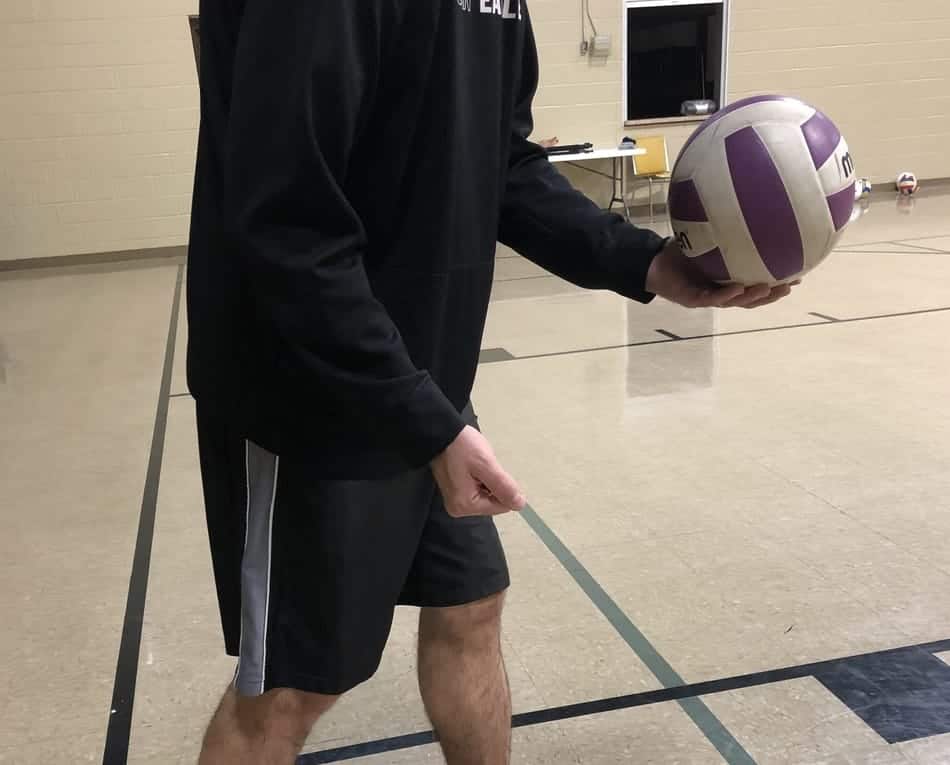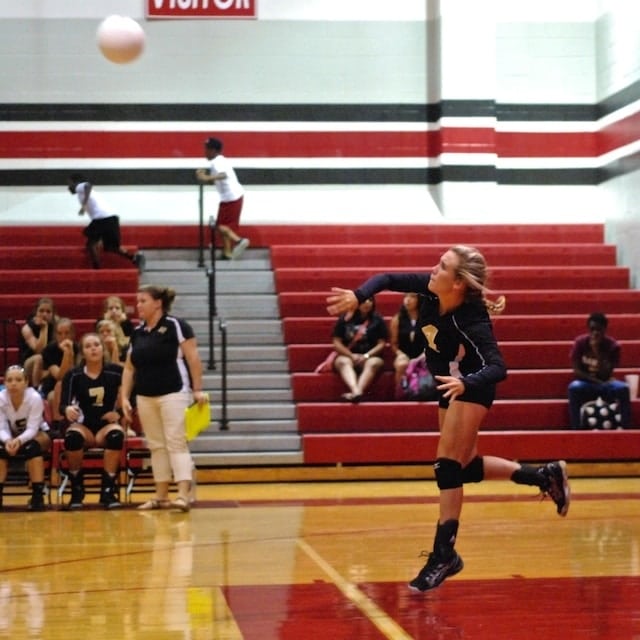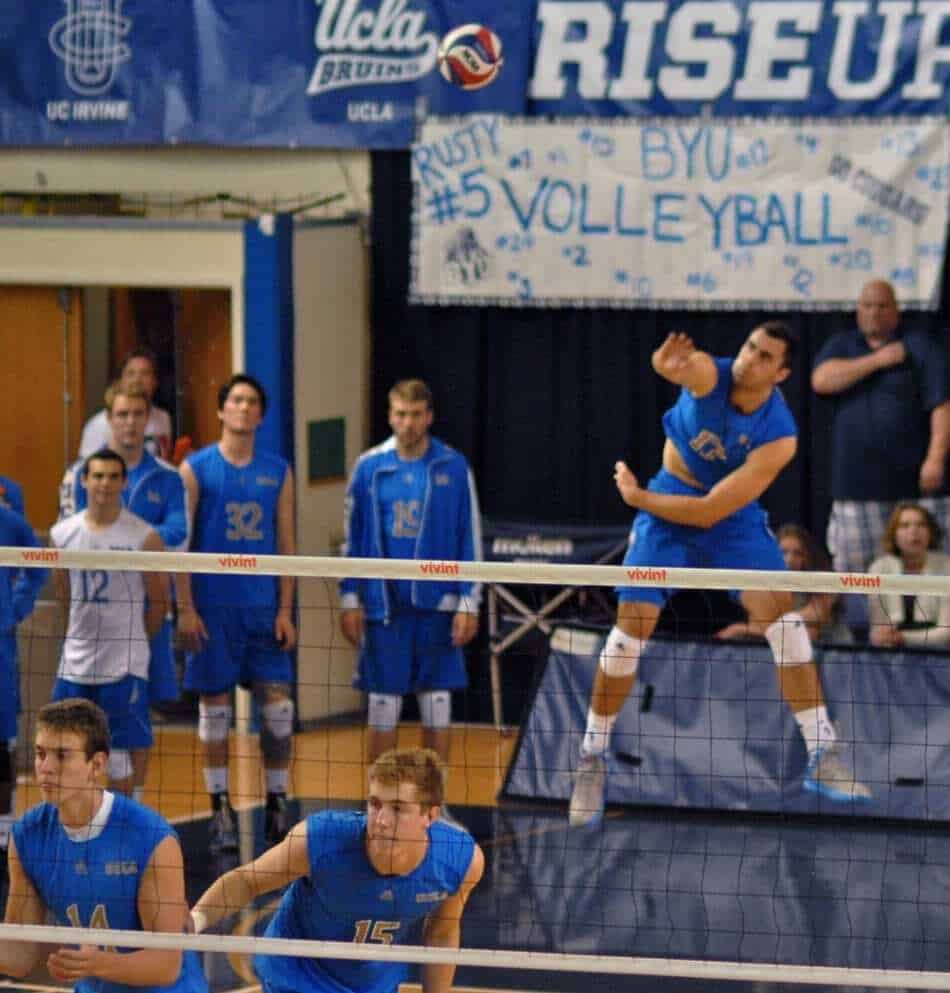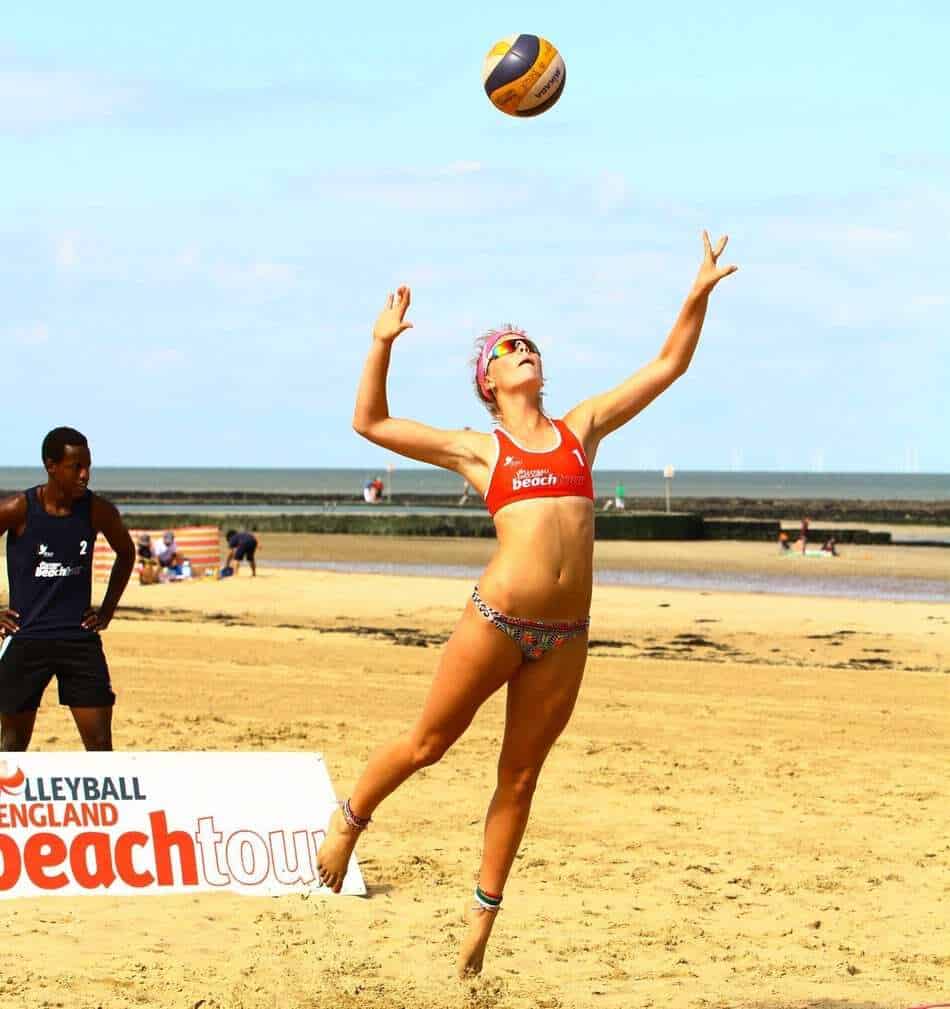Did you know there are 4 main types of serves in volleyball? With practice, you can become a master of at least 3 of them. The fourth is quite challenging and really is for players who’ve mastered the first 3.
What are the 4 types of serves in volleyball? The four types of serves in volleyball are: the underhand serve, the floater, the topspin serve, and the jump serve.
For Every Serve, Here Are Some Tips:
You should be looking at the contract as your hand hits the ball. Not keeping your eye on the ball is one of the biggest causes for mishit serves.
You need to choose a target. Even if you’re a beginner who is simply trying to get the ball over the net, pinpoint your ideal spot that you’re aiming for. For advanced servers, whether you’re choosing a weak player or a corner or a seam between players, pick the specific spot.
You have to stand completely behind the end line (the back line of the court) and stay behind it until the ball has been struck. You may stand anywhere from the left side of the court to the right.
Although the right-hand corner has traditionally been considered the server’s corner, the rules have changed to make serving fair between right-handed and left-handed players. If you typically struggle to keep the ball in bounds to one side or the other, simply move your body further down the line when you begin to set up for your serve. Don’t be shy about this, some of the best volleyball athletes in the world use this technique to control their serves.
The Underhand Serve
For the basic underhand serve, you will use your dominant hand to strike the ball. Stand with your feet about shoulder-width apart, with your non-dominant foot forward.
Hold the ball in your opposite hand, cupping the ball like on a golf tee. Hold the ball low, at around waist level and out in front of yourself.

You should have the same foot forward as the side of the hand holding the ball. For example, a right-handed player will hold the ball in their left hand and their left foot will be forward. This is important for having balance and generating power.
Now you will make a fist with your hitting hand and swing back and strike the ball on the underside using the flat palm side of your fist. You want to create as flat a surface as you can with your fist so that the ball flies straight.
The swing needs to be through the ball – swing as if the ball is further away, don’t let the hand stop immediately on contact. Finally, make sure that your swing is coming up as your fist makes contact with the underside of the ball, you want it to be in an upward motion, almost like a boxer doing an uppercut punch so that the ball is sent on an upward path, not just straight.
If you need more help with your underhand serve, this article is dedicated specifically to that serve.
The Floater Serve
The floater is one of the two main overhand serves. You will begin by facing the net with your feet slightly apart, non-dominant foot forward. Most of your weight should be on your back foot.
Begin with the ball in your non-dominant hand and a great tip is to start with the air hole of the ball in your palm. If you begin this way the ball is going to start with the heaviest part of the ball pointing down, which makes it more likely to “float” or drift in the air.
As you toss it straight up, don’t launch it high into the air, you simply want to raise it quickly to the height your arm can extend for your overhand swing, so usually 12 to 18 inches above your tossing hand.

You should be releasing the toss about level with your head. So the ball will be placed in front of your hitting shoulder and you will be stepping into it with your swing.
Now step forward and swing with an open palm, fingers spread. You want to slap the ball with your firm palm (not your fingers) and pop it, making contact right in the center of the back of the ball. This gives the ball a punch and no particular spin.
It’s critical that you do not snap your wrist as you do this serve. When it’s sailing through the air it is hard to predict and anticipate exactly where it will go because any draft in the air can cause it to shift. The ball often can weave or bob or even just die (drop suddenly) which makes it challenging to play for your opponents.
A really good floater will have a pretty flat trajectory, not a rainbow shape. While it’s always tempting as a server to have the mindset that a harder serve is harder to return, the floater is actually the opposite.
The softer you hit it, the more movement and the more unpredictable it can turn out. This is like the pitcher who uses a change-up in baseball. Everyone gets used to hard, fast and straight, then you pop them with a floater.
The Topspin Serve
The topspin serve is probably the most common overhand serve. You will begin in the same position as the floater serve, but disregard the airhole of the ball.
For this serve, you will toss a little higher and a little more directly above your hitting shoulder than the floater toss. This gives your hand just a little longer to snap your wrist and get that topspin going. Contact the ball higher on the backside of the ball, a little below the middle.
You will snap your wrist like you’re trying to wrap your hand over the top of the ball. This will give it the topspin. It’s important that you follow through with this serve, that ensures the spin and increases the velocity.
Once you are consistent at hitting your topspin serve, start tossing the ball with some topspin. You can easily do this by flicking your wrist toward yourself as you toss. This gets the ball already moving with the spin your hand will be making, which just adds to the ball’s momentum.
The topspin serve is more predictable in its trajectory than the floater which makes it easier for defenders to know how to receive. The difficulty comes from the power (and speed) that you can serve with because the topspin will help the ball curl down after it crosses the net instead of sailing to the back wall of the gym.
You have the potential with some really strong spin to get some aces in 2 situations: players may think the ball will go out, but it drops just inside the line and players think they’re in position to receive and the ball drops just out of reach in front of them.
The topspin serve is more suited to serve deep into the court and it’s easier to hit specific spots because the ball’s flight is more consistent.
The Jump Serve
Jump serves are very advanced and should only be attempted by players who are consistent with their regular standing version. Jump serves can either be a jump floater or a jump topspin.
Basically, these serves are the same except you start several paces behind the service line and perform an approach and a jump. You will do a left, right, left approach just like when hitting.
You will toss just as you begin your approach and significantly higher than the other tosses because the ball has to hang in the air long enough for you to meet it. You can use either hand (or both) for the toss.

Your toss is the most challenging part to master. If you can make your toss consistent, then approaching consistently becomes much more manageable.
You have to jump before the end line. You are allowed to land inside the court after hitting your serve.
What makes the jump serve so difficult is that you have so many moving parts. Any of the other serves you can focus on just making a solid contact. With jump serves you have to worry about a more challenging toss, a correct approach and the timing of it all.
If the jump serve is so difficult the master, why try it at all?
- More power – when you start at a run, you’re transferring more power into your serve which brings the speed of the ball even higher.
- Better angle – even though it’s only slight, when you jump and meet the ball in the air you are serving at a better angle to bring the ball down sharply on the other side of the net.
- It’s intimidating – even if the serve is relatively the same, it’s intimidating to watch the server take a run and launch. Passers have to overcome the nerves of facing that coming towards them.
Need More Power on Your Serve?
Do you want to hit your serves with more power? One of the key coaching tips that often goes unmentioned is to use your core. When you are serving, it’s not just about how hard you swing your arm. It’s actually about arching your back, pushing with your legs and doing a quick crunch motion with your abs. You can generate so much more power and keep from wearing your arm out so quickly.
Serves in Beach Volleyball
A Strong Server
In beach volleyball, a stronger server can be even more of a gamechanger than in the indoor version of the sport. A great server indoors will only be allowed to serve once for every 6 positions that the team rotates through.

In the beach game, there are only two people per team, so a great server makes up half the service rotation possibilities. Volleyball has always been a game that’s easily taken over by a player or team getting on a streak. Beach volleyball is a wide open opportunity for serving streaks.
Factoring in the Wind When Serving
In beach volleyball, the wind becomes a major factor with your serve. You have to consider not just how hard to swing depending on the strength and direction of the wind, but also how the wind direction will affect the flight of the ball. Many beach players will only use their floater when there is little to no wind. This is when the floater can really dance and be difficult to handle. Under windy conditions, a topspin serve is often best because you can control the ball better by giving it the spin you want and serving with enough power to overcome what the wind would likely do to the ball.
The Skyball Serve
The skyball serve is a unique serve that’s pretty rare. Adrian Carambula popularized the Skyball during the lead up to the Rio 2016 Olympics. His method looks very unpredictable and it produces that kind of result. He describes his technique as “stay loose and let it just come natural.” Because there’s no ceiling in beach volleyball, he hits it sometimes as high as 100 feet in the air so that the ball is coming directly down on his opponents. While this might sound like a freeball, it actually presents several challenges.
- Players rarely see it and can find it puzzling.
- The elements can really cause problems (for example staring into the sun, rain could be sprinkling down as you’re looking up and the wind has a long time to affect the ball).
Some players serve a sky ball with no spin, so it will imitate a floater only traveling almost straight down. The ball will bob and weave and juke in the air, making it difficult to pass. Others have learned to put backspin on the ball which gives the receiver a totally bizarre challenge. The ball can be drifting back towards the net (towards the server) as it’s coming down.
Do you understand all the rules surrounding serving? Take a minute and review this article to answer any of your serving questions.
Related Questions
What Is a Sidearm Serve?
A sidearm serve is not normally a recommended serve in volleyball. You stand sideways and do an underhand serve only swinging your arm sideways instead of in an uppercut motion.
For some beginners that can’t generate the power for an overhand serve, coaches may suggest a sidearm serve to make their serve more challenging than a regular underhand. Typically, if these players will just focus on practicing their overhand, they will build up their power and progress more quickly.
What Is a Roundhouse Serve?
If you watch some Asian teams, you may see some roundhouse serves. This is in between a sidearm serve and an overhand serve.
You stand sideways and place the ball similar to an overhand serve only and make contact with it a little lower, like around the shoulder level. Because of the torque, you leverage, this can help children and beginners generate more power than usual.
How to Serve with Side Spin?
While it’s not a traditional
For right-handed servers, the most natural movement is to serve towards the left by hitting on the right side of the center and snapping your wrist sideways to wrap towards the front of the ball. The most effective way is to stand all the way to your right side of the end line and aim for the far left corner. This isn’t a traditional
Photo credits:
Feature image by Keith Johnston from Pixabay
Black team serve image by Casey Stinnett on flickr.com: https://creativecommons.org/licenses/by/2.0/
Jump serve image by KLM volleyball on flickr.com: https://creativecommons.org/licenses/by/2.0/, cropped for size.
Beach serve image by Funk Dooby on flickr.com: https://creativecommons.org/licenses/by-sa/2.0/, cropped for size.
Recent Posts
Athletes, listen up! Do you have a closet full of old jerseys, sweatpants, and tees that you just can't seem to part with? Well, dust them off, because you're sitting on a goldmine of fashion...
You may have heard, or you may have noticed, that there's been a change to the rule about double contact in volleyball. In 2022, an experimental rule change began to be implemented, where the double...
